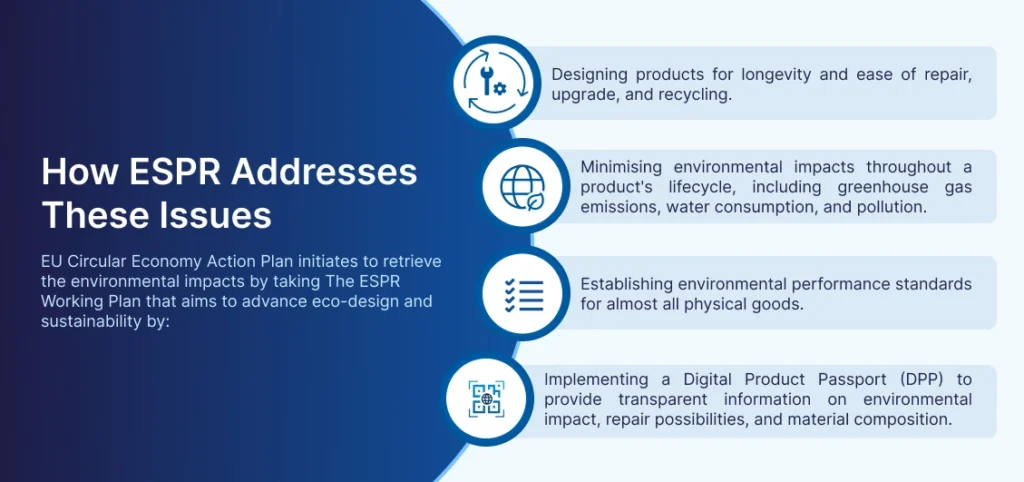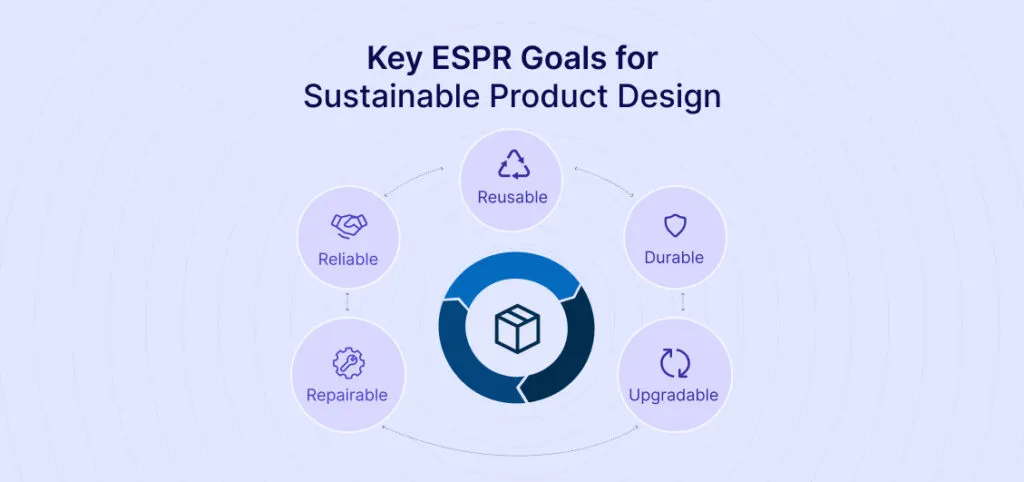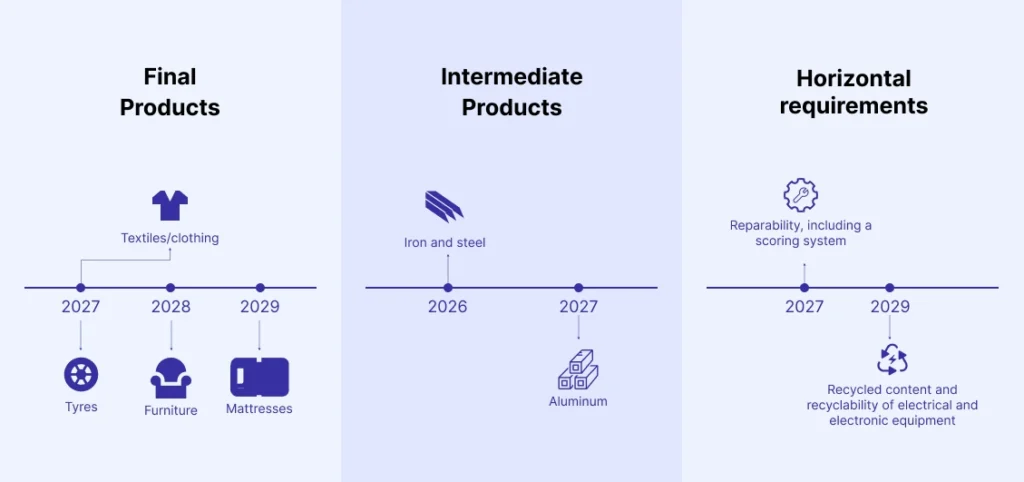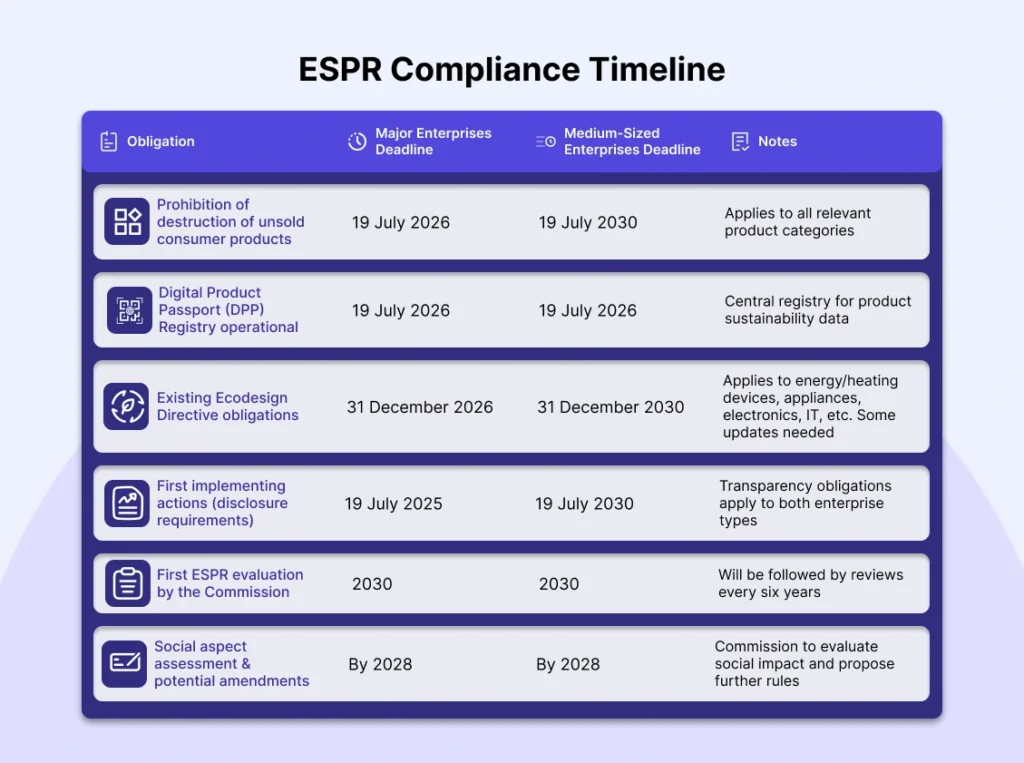
The EU’s Eco-design for Sustainable Products Regulation (ESPR) is reshaping sustainability requirements for nearly all products sold in the EU. The European Union is actively advocating for circularity to be the norm, encouraging sustainable product design, and providing detailed data transparency using Digital Product Passports. This ESPR Working Plan: What EU Businesses Must Know outlines what businesses need to do to stay compliant, which product categories are affected, and the deadlines they have to meet to keep their competitive edge in the EU market.
The European Union is responsible for some of the world's highest consumption of resources, with its residents using more than 2.9 planetary resources annually, significantly exceeding Earth's biocapacity. This consumption largely depends on the unsustainable extraction of minerals, fossil fuels, and biomass, which contributes to global environmental degradation.
Suboptimal Product Design is a major contributor to environmental problems, accounting for up to 80% of a product's environmental impact, largely due to the lack of inclusion of eco-design aspects, which ultimately leads to:
A significant portion of Europe's environmental footprint is outsourced. This occurs through the import of raw materials and manufactured goods from countries with less demanding environmental regulations, effectively shifting pollution burdens (such as mining waste, water consumption, and emissions) to other regions. The EU's contribution to global supply chain pollution is substantial, particularly in areas like deforestation (driven by imports of products like soy and palm oil), textile production, and the manufacturing of batteries and electronics.
Air pollution in European cities remains a significant concern for public health. Within the EU, prominent sectors such as heavy industry, transportation, and agriculture are responsible for substantial emissions, including: Greenhouse gases (GHGs), Particulate matter, NOx, and SOx, Persistent organic pollutants (POPs).

Ecodesign for Sustainable Products Regulation (ESPR) goals are to transform the economy into a circular, sustainable, and competitive economy. The EU aims to transform the consumption system in the EU which is the major cause of climate change and pollution.
The ESPR is part of a measure to reach the targets of the 2020 Circular Economy Action Plan. The Eco-design Regulation helps the EU become more circular and sustainable, aiming to hit environmental, climate, and energy efficiency targets by 2030, and doubling its circularity in material use. The ESPR has expanded the existing Eco-design Directive's reach, which used to only cover energy-related products.

According to the Ecodesign for Sustainable Products Regulation (ESPR) working plan, a list of products is targeted to introduce ecodesign requirements and energy labelling in the upcoming five years.
The new ESPR working plan 2025–2030 outlines key product groups that the commission has prioritised. These include four final products, two intermediate products, and two legal acts establishing horizontal requirements.

Note: Information and communication technology (ICT) products and other electronics are not listed as final products but are affected by both horizontal measures and energy-related product requirements. In addition, sixteen energy-related product categories from the previous work plan (2022-2024) are renewed, including televisions, washing machines, motors, electric vehicle charger and portable electronic devices.

The Eco-design for Sustainable Products Regulation (ESPR) will be subject to both public enforcement and civil liability risks across the EU.
The European Commission may expand the list of affected product groups, which would further increase businesses' exposure.
As per the Ecodesign for Sustainable Products Regulation (ESPR), all products must have a passport, a Digital Product Passport that carries all data regarding the product’s materials to manufacturing to distribution. DPPs are to ensure that data provided are accessible with consent, showing the environmental performance, chances of repairability, the possible presence of concerning substances and the end-of-life or disposal information.
Under the Ecodesign for Sustainable Products Regulation (ESPR), the Digital Product Passport (DPP) is designed to improve:
The idea of Digital Product Passport is generated to bring transparency into action. The DPP is built to provide data accuracy and accessibility regarding environmental and technical information such as product composition, carbon footprint, durability, energy use, and recyclability. This lets the consumers choose an eco-friendly product and the businesses can prove their authenticity about the product’s sustainability information.
The Digital Product Passport (DPP) enables stakeholders to track a product's components and materials throughout its supply chain and lifecycle. This tracking facilitates the tracing of critical raw materials or recycled content's origin, production methods, and usage, thereby supporting circular economy objectives.
By centralising product compliance data in digital form, the DPP helps national authorities and EU bodies monitor and enforce ESPR rules more efficiently. It enables quick checks for conformity, reduces fraud, and improves product recalls or environmental reporting.
The Ecodesign for Sustainable Products Regulation (ESPR) is all about making it easier for sustainable products to move freely around the EU. They're doing this by setting up consistent ecodesign rules and requiring a Digital Product Passport (DPP). The main idea is to avoid any roadblocks that may arise because of different national rules.
To keep the digital product passport adaptable and responsive to market changes and innovation, it should run on a decentralised data system. Businesses should be in charge of setting it up and managing it.
However, for smooth enforcement and oversight, national authorities and the Commission need direct access to a record of all unique product identifiers. To make this happen, the Commission should set up and manage a digital product passport registry for this data. When needed for enforcement, the Commission should also clarify what other digital product passport data should be stored in the registry.
DigiProd Pass offers a streamlined platform to help businesses meet the EU's ESPR (Eco-design for Sustainable Products Regulation) requirements for Digital Product Passports. This interoperable system is carefully designed by the experts to ensure ESPR is compliant with and transparent to the stakeholders. It enables traceability across supply chains, integrates with existing systems, and ensures data is both secure and shareable .
DigiProd Pass supports compliance, builds consumer trust, and simplifies EU market access by making product data accessible to the concerned actors according to ESPR regulation. DigiProd Pass’ real-world pilots, such as with Sourcebynet in Shanghai and BGMEA in Bangladesh, show they’re already helping industries get ESPR-ready.
The EU's new Ecodesign for Sustainable Products Regulation (ESPR) is all about making products better for the planet with enhanced product longevity and recyclability. And the Digital Product Passports (DPPs) help to keep things transparent and trustworthy aligning with circular economy EU regulation.
This whole effort is to limit the EU's ecological impact and build a greener future with clear rules, specific product goals, and thorough evaluations. This benefits everyone, from individuals to businesses, and significantly enhances the EU's leadership in sustainable innovation, ethical production, and climate action.
What is the ESPR Working Plan 2025–2030
Ans: The ESPR Working Plan 2025–2030 is the EU’s official strategy for implementing the Ecodesign for Sustainable Products Regulation (ESPR). This working plan aims to transform the linear economy into sustainable, circular, and energy-efficient by making businesses change their policy & product design. They require durable, reusable, repairable and traceable products with Digital Product Passports. The plan targets key product groups like textiles, furniture, tyres, and electronics to reduce environmental impact, promote resource efficiency, and support the EU Green Deal.
Which products are covered under ESPR?
Ans: The ESPR aims to improve product durability, repairability, reuseability, recyclability to make an eco-friendly consumption system. The prioritised products are clothes (by 2027), furniture (by 2028), tires (by 2027), and mattresses (by 2029). They're also considering materials like iron and steel (by 2026) and aluminum (by 2027). New regulations will focus on repairability (with a scoring system by 2027) and the use/recyclability of recycled electronic materials by 2029..
When do ESPR compliance deadlines start?
Ans: The ESPR compliance deadlines start after the first Working Plan is adopted by April 19, 2025, with some product-specific requirements beginning as early as 2026
https://eur-lex.europa.eu/legal-content/EN/TXT/?uri=CELEX%3A32024R1781&qid=1719580391746
https://ecomundo.eu/en/blog/ecodesign-labeling-energetics-sustainable-products
https://ec.europa.eu/commission/presscorner/detail/en/ip_25_1071
https://www.regulatory-compliance.eu/ecodesign-for-sustainable-products-regulation/
https://www.whitecase.com/insight-alert/eight-key-aspects-know-about-eu-ecodesign-sustainable-products-regulation
https://www.europarl.europa.eu/doceo/document/TA-9-2023-0272_EN.html
https://sustainabilityservices.eurofins.com/news/espr-and-energy-labelling-working-plan/



.svg)
.svg)